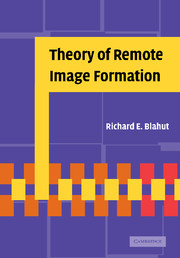Book contents
- Frontmatter
- Contents
- Preface
- Acknowledgements
- 1 Introduction
- 2 Signals in one dimension
- 3 Signals in two dimensions
- 4 Optical imaging systems
- 5 Antenna systems
- 6 The ambiguity function
- 7 Radar imaging systems
- 8 Diffraction imaging systems
- 9 Construction and reconstruction of images
- 10 Tomography
- 11 Likelihood and information methods
- 12 Radar search systems
- 13 Passive and baseband surveillance systems
- 14 Data combination and tracking
- 15 Phase noise and phase distortion
- References
- Index
6 - The ambiguity function
Published online by Cambridge University Press: 19 August 2009
- Frontmatter
- Contents
- Preface
- Acknowledgements
- 1 Introduction
- 2 Signals in one dimension
- 3 Signals in two dimensions
- 4 Optical imaging systems
- 5 Antenna systems
- 6 The ambiguity function
- 7 Radar imaging systems
- 8 Diffraction imaging systems
- 9 Construction and reconstruction of images
- 10 Tomography
- 11 Likelihood and information methods
- 12 Radar search systems
- 13 Passive and baseband surveillance systems
- 14 Data combination and tracking
- 15 Phase noise and phase distortion
- References
- Index
Summary
A two-dimensional radar can be described as a device for forming a two-dimensional convolution of the reflectivity density function of an illuminated scene with a two-dimensional function, called an ambiguity function, that is associated with the radar waveform. A radar uses the delay or the doppler of the received waveform as a means of obtaining surveillance information, and requires the use of waveforms that are carefully designed to provide adequate resolution and avoid ambiguity. The major analytical tool used to design such waveforms is the ambiguity function. The ambiguity function is a two-dimensional function defined as a functional of the one-dimensional waveform. Every one-dimensional waveform of energy Ep is associated with a two-dimensional ambiguity function of energy Ep2, which provides a surprising amount of insight into the performance of the waveform.
We shall introduce the ambiguity function formally here, proving a number of its mathematical properties. We will then study the ambiguity functions of some interesting waveforms. Later, in Chapter 7, we shall study the performance of imaging radars from the point of view of the ambiguity function, identifying the coordinates of the ambiguity function with the delay and the doppler of an echo. In Chapter 12, we shall study the performance of search radars from the point of view of the ambiguity function.
- Type
- Chapter
- Information
- Theory of Remote Image Formation , pp. 186 - 220Publisher: Cambridge University PressPrint publication year: 2004



